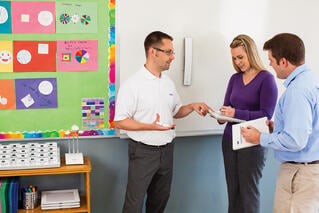Building a T4PD Community, Part 1
In November of 1986, a provocative article appeared in the New York Times with the simple title, “Debating Classroom Technology.” The article posed many intriguing questions about the future of technology in the classroom, at a time when educational technology was still in its infancy. Schools and teachers across the country were struggling to determine whether classroom technology might someday impact student learning: Could technology actually reform the way knowledge is transmitted? What is so compelling about this article, almost 30 years later, is that educators are still searching for the answer to that question.
Obstacles to Creating 21st Century Schools
In 1986, early adopters of classroom technology had few resources and still fewer proven strategies to fully utilize the available technology as a teaching tool. Today, the instructional technology and strategies to effectively redefine how learning should be taking place in a 21st century classroom are readily available. In a 21st century classroom, content and instruction are delivered through a variety of digital resources. Students use instructional technology to learn, create, and share course curriculum with others. The teacher facilitates that learning and is able to provide students with numerous digital resources far beyond traditional, static worksheets and old textbooks.
Unfortunately, however, many schools today are still using 20th century teaching methods and struggling to use technology as a teaching tool. A modern-day follow-up question to the New York Times article would be: Why, in 2015, are so many schools still struggling to transform the learning process through the use of instructional technology? The answer lies in the overtaxed world of the modern educator.

Overburdened Teachers
Properly implementing classroom technology is just one of many things being asked of classroom teachers today. In the current educational landscape, teachers find themselves responsible for far more than simply planning, grading, and facilitating classroom instruction. Classroom teachers are being asked to juggle their teaching responsibilities as well as high-stakes testing, increasing class sizes, student interventions, multiple meetings per week, extra forms to fill out, teacher-based teams, improvement plans, elaborate teacher evaluation systems, funding issues, a lack of resources, and more.
Inadequate Professional Development
In schools where instructional technology is available, many teachers are frustrated by the lack of adequate and relevant professional development to support its implementation. Other teachers also express concern when the professional development offered is beyond their ability level or when it is not relevant to their teaching. Sadly, with all of these obstacles, effectively utilizing instructional technology becomes just one more thing for a classroom teacher to manage within a limited planning time.
A New Strategy for Professional Development
Despite all of the demands placed on today’s teachers, educators across the nation are still striving to use instructional technology effectively. They recognize that teachers and schools must continue to come up with new and innovative ways to adapt their instruction to better meet the educational needs of our 21st century students. Since instructional technology integration can be hindered by the obstacles discussed above, it is imperative that we find a simpler, more basic way to help teachers learn how to use classroom technology. That imperative has led me, and many of my colleagues, to develop a new strategy for professional development known as the “T4PD.” While you might think that T4PD would be a great name for a droid in the upcoming Star Wars movie, in our building it stands for “Teachers Teaching Teachers Technology (Professional Development),” and it has helped build a sense of community among our staff. The T4PD strategy is designed to remove many of the obstacles that often make technology integration difficult.
As educators we have all experienced the cafeteria-style technology in-service, in which teachers are asked to pile into a small room to see a rushed demonstration of a classroom technology available in their school. This type of training session typically offers a small snapshot of how the technology should be used for instruction. Such training sessions often include little time for teachers to ask questions; to practice skills with a hands-on, breakout session; or to make a relevant connection to how the technology might be used in their curriculum. When the technology training session is over, teachers are then directed to move on to the next in-service activity, and the benefit of the technology training is often lost in the clutter. Teachers sometimes leave these types of technology in-services feeling even more frustrated and overwhelmed.
 By instituting a T4PD program in our school, our staff has continued to build a culture of collaboration and connections among teachers, with the purpose of furthering the use of effective instructional technology. We have discovered that the T4PD model is a more productive way to conduct effective educational technology training in our building. The foundation of the T4PD model is a series of one-on-one and/or small-group interactions taught by teachers for their fellow educators. We call these personal and small-group training sessions “technology exchanges.”
By instituting a T4PD program in our school, our staff has continued to build a culture of collaboration and connections among teachers, with the purpose of furthering the use of effective instructional technology. We have discovered that the T4PD model is a more productive way to conduct effective educational technology training in our building. The foundation of the T4PD model is a series of one-on-one and/or small-group interactions taught by teachers for their fellow educators. We call these personal and small-group training sessions “technology exchanges.”
During a technology exchange, teachers share successful technology skills and strategies that have worked in their classrooms. They also share new technology skills with one another. The exchange is done at a convenient time for both educators, usually in a comfortable location, and the technology and curriculum skills they share are conducted at the teacher’s own pace and ability level. Since fellow educators conduct their own technology exchanges, the fear of receiving a poor evaluation from administration due to a lack of technology skills is removed. With each technology exchange, the staff continues to build a positive culture based on trust and appreciation for one another and for the teaching community.
A Closer Look at Technology Exchanges
Technology exchanges are designed to be both comfortable and productive. They may be held on campus in a classroom or a teacher’s lounge. Exchanges may also take place off campus at a restaurant or a local coffee shop. They can even be an online exchange of ideas and expertise through email, messaging, and other digital meeting software. The only strict requirement for a technology exchange is that it be done at a convenient time and location – chosen by staff and not by administrative directive.
A technology exchange may be a simple one-on-one sharing of a skill, strategy, or lesson, but it can also be conducted in a small group. The focus should always be on how the instructional technology can be used in a participant’s class. Exchanges typically include examples of successful technology-based lessons and provide an opportunity for a hands-on experience with that technology, as well as ample time for answering questions. During a technology exchange, the system of one teacher teaching and supporting another allows the time to be used productively. After participating in a technology exchange, our teachers say they feel excited to try using technology in their classroom. They also greatly appreciate the time and expertise of their colleagues, and say that it engenders a sense of community among staff.
Following a technology exchange, teachers can begin to slowly incorporate within their own curriculum the ideas, skills, and strategies they have learned. The relative success of the technology integration during the lesson can be discussed at a future technology exchange, where refinements and adjustments can be made. The strategy can then be passed on to other teachers within our building, during future technology exchanges.
An Organic, Transformative Process
The most fascinating part of the T4PD model is that the process is organic. As more and more teachers begin to use instructional technology, more and more technology exchanges occur among staff. Over time, the school has begun to transform the way knowledge is transmitted to students and the way students learn across the curriculum through 21st century education.
Find out more about the T4PD strategy next week, in Building a “T4PD” Educator Community: Part 2.
Want to connect with your fellow educators? Join the MimioConnect® online community to share and exchange ideas on teaching, technology, and lessons.



